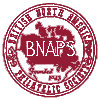Kasimir Bileski — 14 September 1908 to 19 January 2005
John Jamieson
(Published on the Saskatoon Stamp Centre website in March 2005)
Also published in The Canadian Philatelist, Vol. 56, No. 3, May-June 2005.
Canadian Philatelist is the journal of the
Royal
Philatelic Society of Canada.
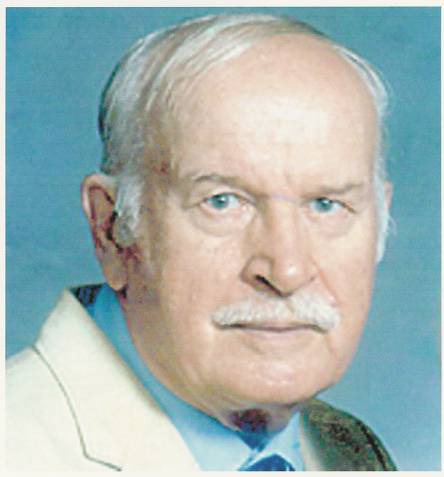
One of the greatest stamps dealers in Canadian philatelic history, Kasimir Bileski, passed away on 19 January 2005 at the age of 96. “K. Bileski” has been one of the best-known names in the stamp industry throughout North America for most of the 20th century. Few collectors will not have seen his entertaining advertisements in the philatelic press over the last 85 years. His first advertisement appeared in 1920, an amazing record for longevity in any business.
Kasimir Bileski was born on his maternal grandparents’ farm homestead near Alvena, Saskatchewan in 1908. He was the eldest of 10 children. His parents, Nicholas Bileski and Caroline Chryk, arrived in Canada from the Ukraine, as children, with their parents, in 1896. Kasimir’s grandparents, Kasimir and Lucy Bileski were given land near Meacham, SK, and the Chryk’s settled in Alvena, SK. Kas lived with his Mother, Caroline, on his maternal grandparents’ farm, while his father, Nicholas, sought work in lumber camps and on the railroad. During this time his Grandfather, an avid reader, subscribed to both Polish and Ukrainian newspapers. With his Mother’s help, Kas was reading both these papers with ease at a very early age. English came when he began school at age 5. It was about this time that the family moved to Saskatoon looking for work and better schooling for the children.
Kasimir was a studious boy and excelled in school. He was always at the top of his class. His mother, Caroline, had impressed upon him that, because he was the oldest, he must always look after his siblings and he always did.
In the eulogy for “Grandpa Kasimir” Allison said; “Kas was a kind soul who always helped those who asked, either with a job, food or money, or a roof over their head. The house was always full of visitors of all sorts. One of his best friends, Sol Kanee, would come over most Sunday mornings for coffee, cheese buns and freshly squeezed orange juice, and they would discuss their stamp collections and world affairs, and if the world had listened to these two old friends, it would be a better place.”
Kas became aware of stamps at a very early age. In one of his mailings, in 1997, Kas stated “Something philatelic did impact itself on my mind at age four. Grandfather had a large Eddy match box with some 50 1¢ Admirals which I’d take out and arrange in various positions”. Hardly a traditional stamp collection but this was Kas’ first exposure to stamps. He went on to say, “By age nine I became aware that the corner Chinese laundry, acting like a sub post office, had letters from China. The friendly Chinese saved their envelopes for me. Soon after I discovered the local news agency got plenty of parcels of magazines and books. On the wrappers were Canadian and USA precancels.” Kas began buying and selling stamps to his school classmates. He said “By age 12, I was aware that it was much easier to earn money by selling stamps”.
Kas gives credit to his Uncle Eugene for getting his business going. Eugene was an adventurous fellow who had been in the Austrian navy and had traveled the world. He jumped ship in Hawaii where he worked as a mail clerk on an inter-island ship, then followed the lure of gold and traveled to the Klondike. Kas said, “... by early 1897 (Eugene) cleaned out some $20,000 worth of gold from his mine ... and departed south.”
So, when his Uncle Eugene moved with his family to Saskatoon, Kas was ready.
Eugene had been a collector for 20 years by this time. On his travels, Uncle Eugene gathered up stamps from the countries he visited. When he finally settled in Saskatoon, Uncle Eugene introduced young Kas to history, geography and the wonders of stamp collecting. In 1920 Kas began to advertise in Saskatchewan newspapers, the beginnings of an amazing business. Kas stated “By age 13, in 1921, I had a contract with Uncle Eugene. He financed me for small amounts. I’d write to different British Colonies, order one set of their current stamps to one pound (for his uncle’s collection) and I also ordered 10 or 20 sets to the one-shilling value. These I sold.” That was the start of his business.
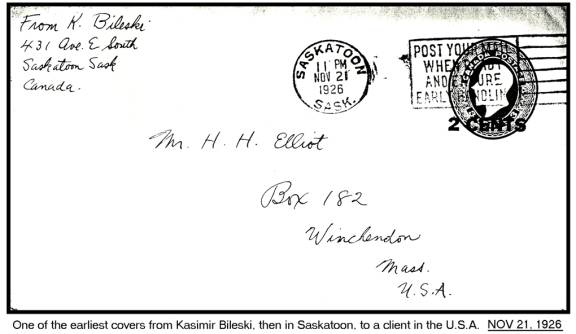
One of Kasimir’s first display advertisements was in the Western Collector in January 1925. He actually began advertising in 1921 but those early offerings, as Kasimir said, were mostly classified ads “at usual 1¢ a word in those days”. Kasimir said his first mail order customer was James Shrimpton of Wadena, Saskatchewan, “and he stayed with me for the next 50 years or more until he had the misfortune to be hit by a car ... he was then 95.”
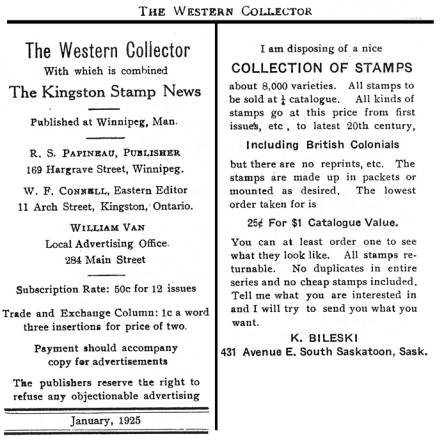
Kasimir graduated from Bedford Road Collegiate in Saskatoon, first in his class, in 1927. He immediately went to Normal School in Saskatoon, to become a teacher. After graduation, he went to the tiny community of Kamsack, Saskatchewan, to teach in the one-room school there. He had early ambitions to travel the world that he had been introduced to through the stamps and he really did not enjoy teaching. An entry in his diary on 31 October 1931 states, “Now I am a teacher, and have been at it for four years nearly, which is just about enough to last me 40 years.” It was the beginning of the depression, not a very prosperous time for most folks on the Canadian Prairies. The end of Kas’ teaching career came only a few months later when they cut his annual salary from $700.00 per year to $400.00. Kas had continued to buy and sell stamps during his teaching years and was continually learning and gaining a reputation as a knowledgeable stamp dealer. So, when his salary was cut, he resigned his teaching position in December 1931, bought a motorcycle, and taking his most valuable stamps in one book headed east to Montreal where he eventually sold the motorcycle and booked passage to London, England, beginning his world travels and philatelic adventures.
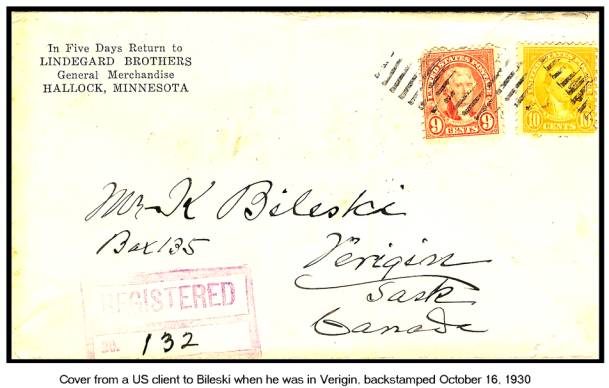
During his time teaching Kasimir met a young girl from the neighbouring district of Verigin at a local dance, Eugenie Negrych. During his time in London, he corresponded with Eugenie, and he eventually asked her to come to London to be married. She did and they were married on 2 January 1935. The couple worked together, in London, building the business together. Daughter Jeannette was born in June of 1936.
During his time in London, Kas haunted the auction houses, rooting through mixed lots looking for hidden treasures. He dealt with Stanley Gibbons and was in an informal partnership with Mick Michaels. In her eulogy at Kasimir’s funeral, granddaughter Allison mentioned one of Kasimir’s favourite stories about his time there. “Stanley Gibbons’ office was upstairs in a building and Kasimir’s and Mick Michaels’ store was downstairs, down six stairs, and they were more successful than Gibbons because it was easier for customers to walk down the six stairs to their shop than up the stairs to Gibbons. Tired feet prefer to go down.”
In another of Kas’s mailings, at the time of Mick Michael’s death in 1988, Kas was reminiscing about his time in London. “I had arrived in London late 1932 and began soaking up a very welcome education by attending stamp auctions almost daily. At one of these, I met a young man a bit younger than myself. It was Mick Michael. Both of us were not exactly well off, especially in 1932, but by then I had a few hundred customers in Canada and the U.S.A. and Mick, besides knowing inner London with its nooks and crannies where many stamp dealers operated, knew one of these very well. This was a fine old English gentleman, H. E. Wingfield. He had saved up some money. So Mick and myself started up an informal partnership. We would borrow one hundred pounds now and then from Mr. Wingfield, scour the auction houses or dealers for bargains, I’d ship them off, mostly to the U.S.A. and life went on smoothly. Our partnership lasted about a year and then each of us went his way.”
In England, in 1935, Kas borrowed $75,000.00, a tremendous amount in the middle of the depression (something like $7,500,000 today), and bought the incredible Lamborn collection. Kasimir wrote in 1984 about this incredible collection: “Depression? There is always lots of money around for good stamps ... I had lots of fun selling such things as blocks of four of all the Australian mint Kangaroo £2 at $100.00 a block ... there were 20 assorted blocks of these in various shades, some with plates.” These now catalogue about US$10,000 “per block” in the current Scott catalogue. “There were over 30 superb NH blocks of Great Britain #176”, the £ Seahorses which he sold at $50 per block. These now catalogue at over $5,000.00 per block. Both only 100 times what they were in 1935.
Kasimir and Eugenie remained in London until 1938, when the rumblings of war, and homesickness for Canada, took them back to Winnipeg.
They purchased the property on Kildonan Drive in 1938 and built a house. This was to be their home for the rest of their lives. In 1939 their son, Eugene, was born and son Felix arrived in 1944.
One of Kasimir’s first “big deals” after returning to Canada was the purchase, in 1940, of the correspondence between Mrs. Parkman of Boston and her sister Mrs. Cordner of Montreal. This lot included over 1600 covers from 1851 to 1870, half from U.S.A. to Canada and the other half from Canada to the U.S.A. He paid $2,000 for the lot, which included 160 6d covers (#2 & #5), 30 3d pairs on cover (#1 & #4), and 400 10¢ Consorts (#16 & #17). He sold the 6d covers for $50 each at the time. Many of the Parkman covers went to Vinnie Greene. One nice 6d on cover now sells for $2,000.
The business grew and in 1948 a new office was built. It was a lovely building, carefully designed for the stamp business. As you can see in the photo, there were lots of large windows that slanted “outward” from bottom to top so that the workers had wonderful “north light” but with no glare from direct sunlight. The basement was full of supplies. I think Kas must have bought a few million of those pastel pink and green envelopes that virtually everything they sold for 50 years seemed to come in. The second floor attic was the kids’ play area when they were young, and there was a spiral staircase from the basement directly to the top floor so the kids could come and go without interrupting the workers in the main floor offices. Of course, the building was absolutely full of stamps from top to bottom.
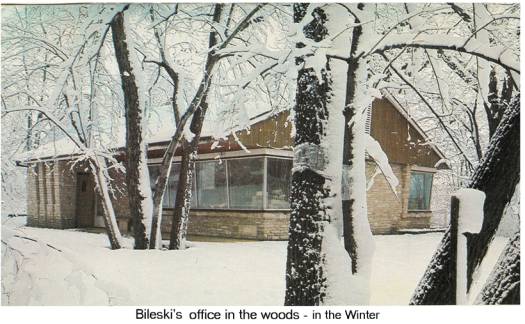
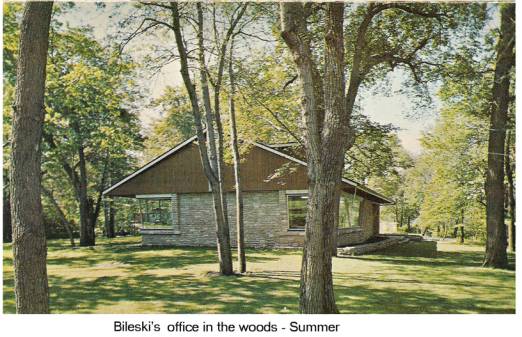
What a lovely place to work!
On my first visit to Kasimir in Winnipeg, I can recall standing carefully in the narrow aisles between shelves full of stamps on one side and boxes full of goodies and collections on the other, afraid that I would bump something or knock over some box full of the latest booklet pane. Kas would be talking about some rarity and would casually reach up to some shelf and pull out one of many boxes and produce that rarity from among dozens of stamps that I would love to have had the problem of selling myself at the time.
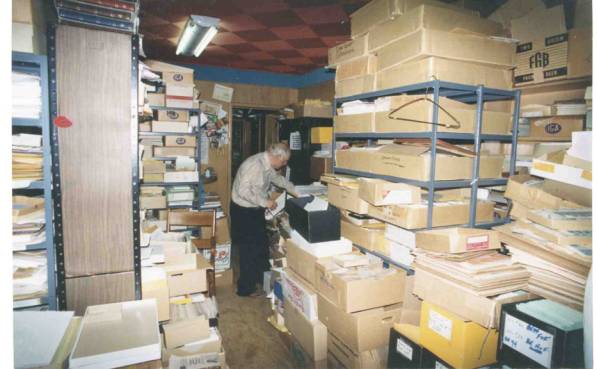
Kasimir is shown here, hunting for that rarity among the mass of stamps in his office.
“I went back to Canada in 1937 and did not revisit London until 1954. Saw a few dealers, amongst them Bill Lea who had a second floor office in the Strand. Had heard he was the man to see for Canadian stamps and sure enough, when I went in, there was Bill Lea pricing up the first page of quite a collection. He had just purchased the famous Lees Jones Canada collection. There on the priced page were eight 12d Blacks: a cover, one mint, a used pair and four other singles. Since I had never had a 12d previously it took but a few moments to buy the page.” Rather a significant “start” to stocking such a rarity. This group of 12d Blacks would be worth close to $1,000,000 today.
Kasimir and Eugenie took many trips for business. In 1946, they traveled to New York for the Roosevelt auction. In 1948 they visited artist, Arthur Szyk, in New York. Szyk later designed Kasimir’s well-known letterhead.
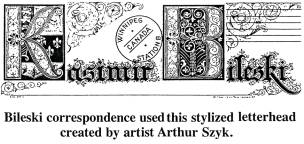
In 1954 they traveled to Egypt for the King Farouk auction. Then, in 1990, they again were in New York for the American Bank Note Company Archives auction where Kas, then 82 and still going strong, was one of the single biggest buyers, reportedly spending around $1,000,000.
In the summer, Kasimir golfed twice a week and was an avid bowler in the cold winter months. Kas once wrote: “golf was the best outdoor hobby and stamp collecting was the best indoor hobby”. They had a cabin at Falcon Lake, which was built in 1957, and every August Bileski would close up the business and spend the month there swimming, golfing, picking blueberries and relaxing. I remember Kas telling me that he subscribed to numerous magazines that he just never got to during the busy winter season, and it was in this month at the Lake that he caught up on some of his reading.
In 1960 Kas took his sons, Eugene and Felix, to London for the big international exhibition there. In the 1930s Kasimir and Eugenie had lived in Ruislip, a suburb of London. Kas took the boys to see “the old home”, and found that it had been completely destroyed in the London blitz. Certainly a reminder of how wise the move back to Canada in 1937 had been.
Allison, in her eulogy, tells some great stories of her grandfather. One of these goes: “Kasimir was a complete pacifist — he would never kill so much as an insect. He would catch a fly in his hand, shake it up, then open the door to let it out, letting in five more in the meantime.” The property on Kildonan was a huge riverside lot. The house was at the front on the street and hidden way at the back, near the river, was the office, with a long meandering wooden walk through the trees between. Allison continued: “He said weeds have rights too, so never clean the garden.” The huge yard was full of trees and she said “Kas fed the birds and squirrels for his entire life; they would wait for him to come by at 8:00 in the morning with his handful of peanuts and sunflower seeds.”
What better life ... stamps ... in the middle of a natural wooded haven in the middle of a big city!
On 5 October 1950, he bought the famous 2¢ on Laid paper (Scott #32) from the Dr. Lewis Reford collection at Harmer, Rooke’s auction in New York. He paid the princely sum of US$3,800.00 for this great Canadian rarity formerly in the Ferrari collection. He held this stamp for over 40 years until, in February 1993, it was finally sold to dealer Daniel Eaton of Vancouver who stopped in Saskatoon on his way home from Winnipeg and quickly sold it to the Saskatoon Stamp Centre. It last sold in 1997 for over $200,000.
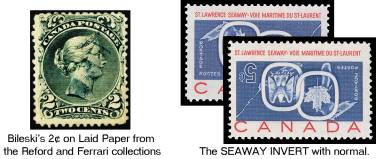
On 9 September 1959, Bileski announced the original discovery of the Seaway Invert error, one of the most spectacular Canadian errors. They were first discovered when an office clerk, in Winnipeg, purchased 30 of them on 20 August 1959. Three immediately went on mail before the error was noticed. The rest were sold to Bileski. The errors were found in Peterborough, Picton and Ottawa in Ontario as well as the Winnipeg find as Kasimir made every effort to corner the market on them. On 5 November 1959, it was reported that Bileski had purchased the Picton, Ontario, find from Jim Sissons, the leading Toronto auctioneer at the time, for $21,250. There were 22 copies in that lot, including a mint block of 12, block of four, four other mint copies, a used copy on card and a damaged copy on a cover. Kasimir was responsible for promoting this great error stamp in the mainstream newspapers as well as in the philatelic press. He even appeared on Front Page Challenge, stumping the panel with news of this great error. It made “K. Bileski” a household name across Canada at the time. The Seaway Invert now catalogues $15,000 for a VF mint single.
Besides the Seaway Invert, Kasimir was a great promoter of all sorts of other stamps. A note from Kasimir received in April 1995, tells how he bought two complete imperforate sheets of the imperforate 1898 Map stamp at the Harmers auction in March 1973. Then he bought the other seven imperforate sheets of 100 from the Trustees of the estate. There were four distinct shades and sets of the four pairs come on the market from time to time ... usually in one of those pastel green envelopes with a K. Bileski write-up.
Another note from Kasimir dated 15 February 1993 talks about the Missing Hologram sheets he was after at the time and all the other varieties he and his staff had found on this stamp during their searches. At the time, he had already bought 50,000 sheets — $420,000 face value — (in sealed pads directly from the Post Office) and checked every one looking for the elusive errors. Yes they did find some, but they had an awful lot of “postage” to get rid of.
Of course, phosphor tagging on Canadian stamps was first used on an experimental basis in Winnipeg and Kas was deeply involved in promoting this new type of stamp to the philatelic world. Almost every first day cover of these new stamps bears the “Winnipeg Station B” cancel organized by Bileski. Kas was the first to recognize varieties of the tagging bars and started a whole new collecting field.
While Canadian stamps were always his favourite, he was happy to handle any worthwhile collection ... the bigger the better.
While still in London in the 1930s, Kasimir bought up huge box lots of Liberian stamps and became the leading dealer in the stamps of that country. He broke up the unique sheet of 60 of the 1906 Inverted Elephant, now a world-class rarity. He published H. Rogers’ A Century of Liberian Philately in 1971, a beautiful and comprehensive 204 page book listing all issues from 1860 to 1960 including all known varieties. It is really a wonderful work regardless of what country’s stamps you collect. He single-handedly made the stamps of this little known country a very highly sought after field.
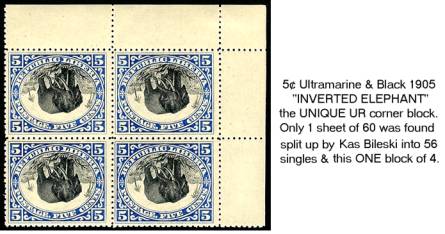
Poland? Well, as noted above, Kas had some Polish ancestors. In one of his mailing in March of 1988, he talks about being back in London in 1954 and buying a 60-volume collection of Poland from Mick Michaels. It had belonged to a former pre-war Polish Consul to London. First volume had 100s of Poland #1 (now Scott $200 each).
Then there was the Perkins Bacon Archives that Kasimir purchased from Robson Lowe in London. It was full of wonderful proofs and imperforates. Most of the listed varieties of Newfoundland came from this lot through K. Bileski.
In the 1990 American Bank Note Archives auction sale at Christies, Kasimir was one of the biggest buyers and much of the $1,000,000 he spent there was buying proofs and Specimen overprints of the stamps of various South American countries.
Kasimir was diagnosed with Parkinson’s when he was 70. It wreaked havoc with his physical well-being, but he did his best to ignore the symptoms and continued with his business. He had to give up golf and bowling, and content himself with watching his favourite, Tiger Woods, on TV. In spite of the Parkinson’s, he retained his mobility until he was 95, going down the path to his office almost every day.

Kas was certainly one of the leading experts in Canadian stamps through the 20th century. He authored several books and catalogues, many of which contain information that is not available elsewhere and are still in demand by serious collectors, 20 to 30 years after they were last published.
Kasimir was very proud of his Ukrainian heritage, but was most proud to be a Canadian. He was awarded the Governor General’s Medal in honour of Canada’s 125th Anniversary, in 1992, in recognition of his promotion of Canada and Canadian stamps to the rest of the world.
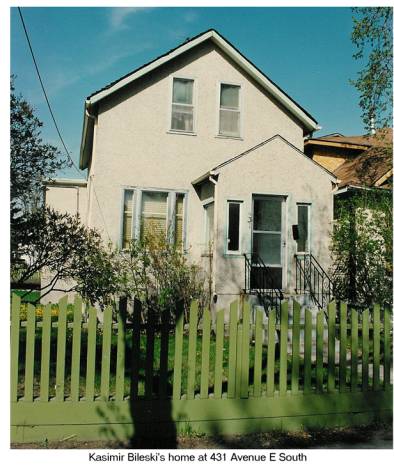
A couple of personal reminiscences I have from knowing Kasimir ever since I was first involved with stamps. There are some interesting “personal coincidences” between Kasimir and my life and philatelic career. Kas spent his youth in Saskatoon, living at 431 Avenue E South, where he started his business. I grew up at 316 Avenue E North, a mere seven blocks apart. Kasimir graduated from Bedford Road Collegiate in 1927 at the head of his class. I graduated from Bedford Road Collegiate in 1968 (about 39th in my class as I was already spending all my spare time in the stamp business). Kasimir first began selling stamps to his fellow classmates in 1920 at the age of 12. I too made a few little deals with my classmates, having placed my first advertisement to sell “Canada, American and foreign stamps” in the Caswell “Bugle” public school paper in December 1962, when I was 12.
I learned early on, as Kas had 50 years before, that unusual stamps and varieties — those “unlisted” items — are far more interesting to advanced collectors (who have all the normal stuff). Bileski’s stories on all the stamps he offered have been a great inspiration over the years in my own career in the stamp business.
Shows? In about 1985, I asked Kas if he ever took tables at stamp shows? He said, “Yes, he did Capex.” Thinking “Capex 1978” I said “Oh? I didn’t recall seeing you there” to which he simply replied “Capex 1951”. The business ran just fine from Winnipeg all those years without ever attending a show. The huge advertising budget over the years in all the philatelic press brought the collectors to “K. Bileski” through the mail. He didn’t have to go out looking for more.
So who bought all Bileski’s stamps? At one point, Kasimir estimated that he had served 200,000 different clients during his long career. In a mailing in March of 1997, at age 87, he commented on having been in the stamp business for 75 years. He said “My main ambition is to make it to 1 January 2000” when at least he will approach the record of 79 years in the stamp business held by Nissim Cappon of Sarajevo, Bosnia.” Well he certainly beat that record, staying active in his business until his 94th year ... 82 years in the stamp business.
And the business carries on. Kasimir’s daughter, Jeannette Warga, and his granddaughter, Allison Pauls, who have worked with him in the business for decades, continue to operate the business. Their colour ads appear in the philatelic press regularly and their website still offers those special deals. I would expect it would take them until they too are 96 to clear out all the stamps that are still waiting to be offered in one of those interesting “K. Bileski” promotions.
Kasimir’s beloved wife, Eugenie, passed away in 2003 after 68 years of marriage ... another “Bileski record”.
Copyright © 2005 John Jamieson
Web design copyright © 2013-2026 The British North America Philatelic Society.
The documents on this website are for informational and non-commercial or personal use only.
Documents on this website shall not be used on other websites or for commercial purposes without permission.
This page was last modified on 2022-01-18
